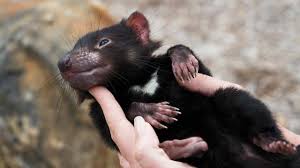Deakin
University scientists may have found a way to stop the cancer that has been
killing Tasmanian devils for the past 20 years.And the devils Sarcophilus harrisii could actually already hold the solution –
natural antibodies found in the marsupial's immune system.
Beata Ujvari, from Deakin's Centre for Integrative Ecology within the School of
Life and Environmental Sciences, investigated differences in molecules found in
the devils' immune systems, comparing those that had the cancer, known as the
Tasmanian Devil Facial Tumour Disease, and those that didn't.
 "We know from human and animal studies that certain natural antibodies are
able to recognise and kill cancerous cells, so we wanted to see whether the
presence of these molecules would also determine tumour development in
Tasmanian devils," Ujvari said.
"We found that devils that have a higher ra We can deduce then that devils
with higher natural antibody ratio are therefore less susceptible to the
contagious cancer."
"We know from human and animal studies that certain natural antibodies are
able to recognise and kill cancerous cells, so we wanted to see whether the
presence of these molecules would also determine tumour development in
Tasmanian devils," Ujvari said.
"We found that devils that have a higher ra We can deduce then that devils
with higher natural antibody ratio are therefore less susceptible to the
contagious cancer."
 Ujvari said the results could potentially halt the spread of disease that has
devastated the Tasmanian devil population since its first sighting in 1996,
hopefully enabling new vaccine and treatment options.
"Anti-tumour vaccines that enhance the production of these natural
antibodies, or direct treatment of the cancer with natural antibodies, could
become a solution to help halt this disease.
Ujvari said the results could potentially halt the spread of disease that has
devastated the Tasmanian devil population since its first sighting in 1996,
hopefully enabling new vaccine and treatment options.
"Anti-tumour vaccines that enhance the production of these natural
antibodies, or direct treatment of the cancer with natural antibodies, could
become a solution to help halt this disease.
 "This process known as 'active immunotherapy', is becoming more and more
accepted in treating human cancers, and we think it could be the magic bullet
in saving the Tasmanian devils from extinction."
The facial cancer is spread from devil to devil via biting during social
interactions, and has caused massive population declines of Tasmanian devils
since its first sighting in 1996, in Tasmania.
"This process known as 'active immunotherapy', is becoming more and more
accepted in treating human cancers, and we think it could be the magic bullet
in saving the Tasmanian devils from extinction."
The facial cancer is spread from devil to devil via biting during social
interactions, and has caused massive population declines of Tasmanian devils
since its first sighting in 1996, in Tasmania.
 Ujvari said that because the cancer was transmitted from devil to devil, their
immune system should recognise the cells as foreign objects, like a pathogen,
and work to eliminate them from the victim's system.
In 2009, the Australian Government listed the Tasmanian devil as Endangered
under national environmental law. It is also listed as Endangered under the
Tasmania's Threatened Species Protection Act 1995.
The Tasmanian devil has also been listed as Endangered on the Red List of the
International Union for the Conservation of Nature and Natural Resources
Ujvari said that because the cancer was transmitted from devil to devil, their
immune system should recognise the cells as foreign objects, like a pathogen,
and work to eliminate them from the victim's system.
In 2009, the Australian Government listed the Tasmanian devil as Endangered
under national environmental law. It is also listed as Endangered under the
Tasmania's Threatened Species Protection Act 1995.
The Tasmanian devil has also been listed as Endangered on the Red List of the
International Union for the Conservation of Nature and Natural Resources
- Blogger Comment
- Facebook Comment
Subscribe to:
Post Comments
(
Atom
)
0 comments:
Post a Comment
Please insert your comments here